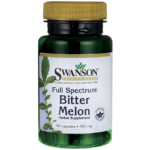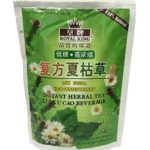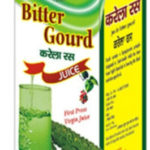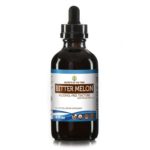FUN FACTS
BN: Momordica charantia AKA 苦瓜 (kǔguā ), bitter gourd, bitter squash, balsam-pear, gohyah tea. In Chinese cooking, it's often stir-fried, or used for soups.
CONSTITUENTS
Contains beta-carotene, lycopene, zeaxanthin, carotenoids, momordin, vicine and charatin, peptide, cucurbitacins, glycosides, and alkaloid. Vitamin C, A, folate and small amounts B vitamins, calcium, magnesium and phosphorus, potassium, and fiber. Flavonoids, coumarins, anthroquinones, anthocyanins and phenolic acids.¹
USES/BENEFITS
(Disclaimer) Treat type 2 diabetes by lowering blood sugar, reduces ulcers and liver problems. Anti-cancer - may interfere with growth and development of cancer cells. .
CAUTION
Diabetes: Be careful when using bitter melon oils, extracts, and other supplements if you are taking diabetes medication. The interaction may cause blood sugar to be too low. I've never taken bitter melon other than cooking the fresh fruit with meat and vegetables. Pregnancy and breast-feeding: chemicals in bitter melon may stimulate menstrual bleeding and have caused abortion in animals. Stay on the safe side and avoid use. Surgery: Bitter melon's blood sugar effect may impact surgery. Consult your physician about taking herbs at least 3 -4 weeks before a surgery.
TYPES

Taiwan White or White Pearl is less bitter than its green counterpart. It is used in stir-fry, salads and soups.
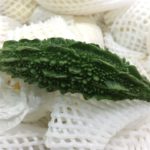
Indian Bitter Melon, AKA Karela has tapered ends and small spikes and knobs on its skin. It's roughly 4 to 6 inches long, shorter than Chinese bitter melon. Photo credit: specialtyproduce.com
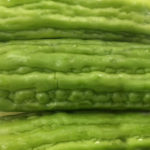
Hong Kong Green is popular in China and the bitter melon I'm used to eating. It's what you'll often find in Chinese stores.
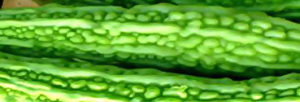
Japan Long looks like the Hong Kong green except it's about twice as long (12 to 14 inches).
GROWING
Bitter melon vines can run 6 to 8 feet long. They can be left on the ground or trellised. Bitter melon is easy to grow. I remember growing them in the front yard of my parents house. We use to run the vines over the small tree they grew under. Mom said that way, you don't have to set up a trellis.
Bitter melon is an annual but can be a perennial hardiness zones 10 and 11. Bitter melon thrives in daytime temperatures around 80 degrees. Seeds should not be planted into the ground until the soil is warmed to 65 degree or more.
— Starting from seed
TCM NOTES
This information is for education purposes only. Seek the advice of your physician before taking any home remedies, herbs, or supplements.
| Temp | Taste | Ent. Meridians | Photo |
|
Cold
Name 苦瓜 kǔguā |
Bitter
|
Heart Spleen Stomach
|
|
| Indications/Issues | Description / Symptoms | Usefulness(1-10) |
| High blood sugar | ♦♦♦♦♦♦♦♦ | |
| Actions | Description / Symptoms | Usefulness(1-10) |
| Remove toxins | ||
| Clears summerheat | ||
| Improves eyesight | ||
DOSAGE information found online
Always consult your doctor before taking any herbal supplements.
PARTS USED
• Fruit
***Always consult your doctor before taking any herbal supplements.***
Contraindications
Drugs Interactions
Herb Interactions
Xiang Fan/ Incompatibility:
Xiang Wei/ Counteraction:
Xiang Sha/ Suppression:
Xiang Wu / Antagonism:
Xiang Xu/ Accentuation:
Xiang Shi/ Enhancement:
The roots of this herb is an ingredient in the following formulas:
PRODUCTS
Google "bitter melon" or its scientific names, with any of the following categories to find the variety of products. Below are links to a few examples - not a comprehensive list.
EDITOR NOTES
I hated bitter melon dishes up till I was a teenager. In our family, this gourd is used as a vegetable. My grandmother typically made it as a soup or in stir fry. After a while, the gourd became an acquired taste. I didn't know about its effectiveness with lowering blood sugar until I was diagnosed with pre-diabetes and started doing research on how I can influence the chemistry of my body to lower the risk. I've eaten it for lunch off and on and actually saw some impact on my fasting blood sugar.
— DRIED
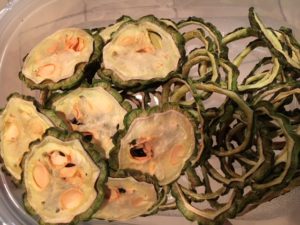
I saw that many places sell them as dried overpriced dried herbs. I used my dehydrator (set it at 140 degrees for 12 hours) and it was easy to dry them. I don't like the innards so I only used the rinds. I tried using them in soup. But honestly, bitter melon is best when it's fresh. Especially if you cook it with chicken, pork or beef. When you eat it with meat, it's easy to overlook the bitterness.
—RECIPES
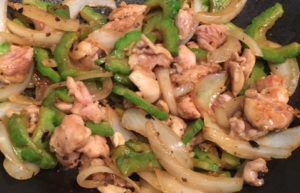
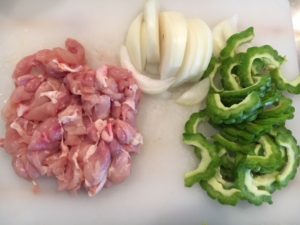
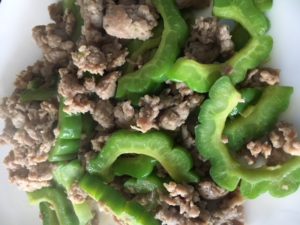
I typically do a 1 part bitter melon and 2 part other items like chicken, sausage, onion, beef, etc. Adding sugar and other spices will also mitigate the taste. And if you add black beans and/or soy sauce, it's going to taste good regardless. Just remember that less melon means less bitterness. You can find many recipes online. Here are a few recipes that I enjoy: organicauthority.com, allrecipe.com, thaitable.com
REFERENCES
- Nagarani G, Abirami A, Siddhuraju P. Food prospects and nutraceutical attributes of Momordica species: A potential tropical bioresources – A review. Bioresource Technology Lab, Department of Environmental Sciences, School of Life Sciences, Bharathiar University, Coimbatore 641 046, Tamil Nadu, India. July 3, 2014
This information in this post came from many sources, including class notes, practitioners, websites, webinars, books, magazines, and editor's personal experience. Always consult a doctor prior to using herbal medicine. The information here is strictly for educational purposes.

